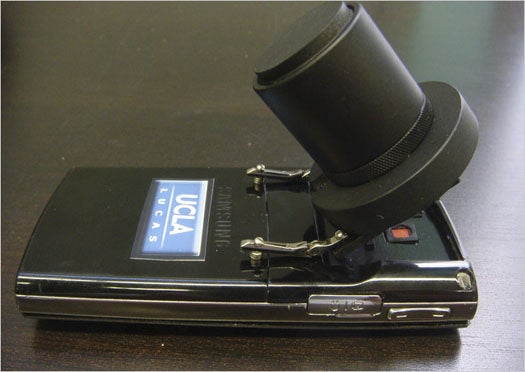A Software-Powered Cell Phone Microscope That Doesn’t Need Special Lenses
We may earn revenue from the products available on this page and participate in affiliate programs. Learn more › We...

We may earn revenue from the products available on this page and participate in affiliate programs. Learn more ›
We know, we know: turning a cell phone camera into a microscope isn’t exactly a technological breakthrough. In fact, our Best of What’s New coverage last year included the CellScope, a cell phone add-on developed at UC Berkeley packing high-powered optics allowing users to transmit images to far-away health centers for diagnosis. But researchers at UCLA have upped the ante, creating a $10, off-the-shelf microscope addition for cell phones that dispenses with the microscope optics altogether.
Dr. Aydogan Ozcan has formed a company, Microskia, to commercialize his innovative approach to microscopy that can cheaply turn nearly any cell phone camera into a diagnostic tool that can detect problems on-site as well as beam data from remote places to far-away hospitals for speedy evaluation.
While all that is not necessarily novel — the CellScope, after all, can help health care workers diagnose tuberculosis or malaria in far-flung corners of the world — Dr. Ozcan’s devices does it all via a novel approach that trades lenses for light-emitting diodes. Inexpensive LEDs added to the phone shine light on slides inserted in front of the camera’s standard lens. The light waves hit the cells on the slide, scattering in unique ways off the cells that are detectable to the phone’s camera sensor.
The waves disrupted by the cells create patterns called holograms that contain lots of useful information about what’s going on in the sample. The images can be mathematically reconstructed on computers to look much like those you would see through a true lab microscope. But Dr. Ozcan’s system can potentially process blood and other samples faster. Because the image captures all the holograms simultaneously on the same slide, it’s very fast and simple to see the anomalies, the cells that don’t look right among a sample of healthy cells.
That means quick diagnoses for people living in the remotest areas of the world, where speedy diagnostics — or perhaps diagnostic tools at all — are rare. Coupled with a $10 price tag and a lack of complicated or delicate moving parts, Dr. Ozcan’s system is indeed a breakthrough, if not for technology than for the economics of health care delivery in parts of the world that need it the most.